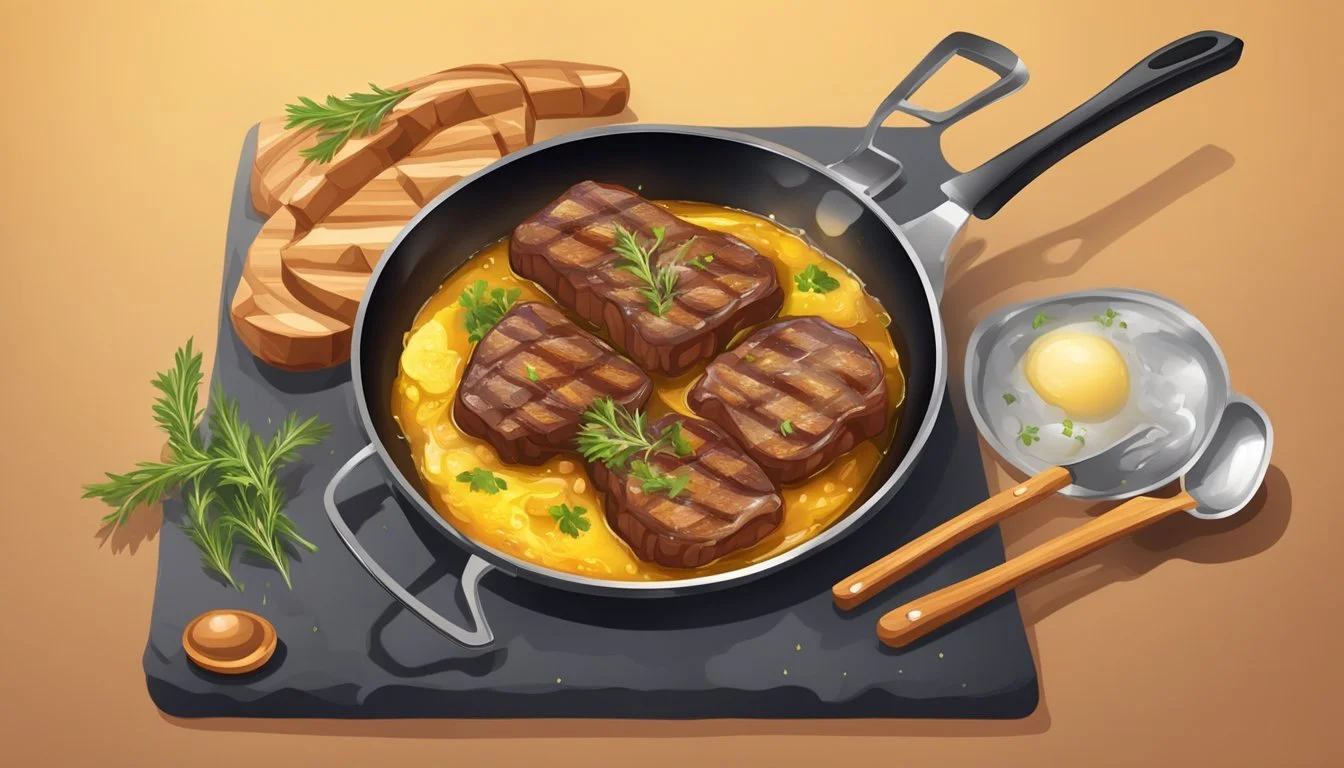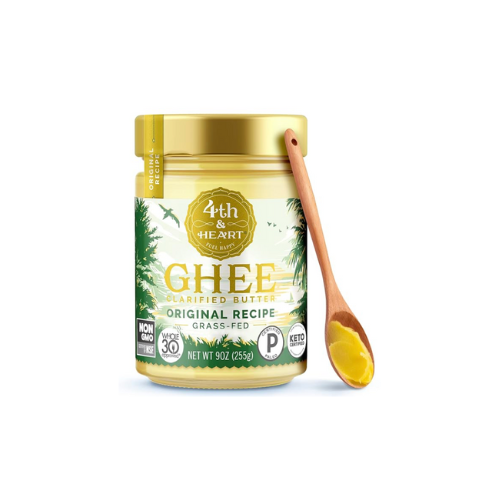Ghee Carnivore Diet
Unveiling the Benefits for Meat-Based Lifestyles
Ghee occupies a prominent place in the dietary landscape of those adhering to the carnivore diet, a regimen that emphasizes the consumption of animal products and excludes plant-based foods. This pure form of clarified butter is celebrated for its high smoke point and impressive nutrient profile, making it an ideal fat source for those on this diet. By removing the milk solids from butter, ghee is left with rich, healthful fats and fat-soluble vitamins such as A, E, and K2, which support immune function, skin health, and nutrient absorption.
The carnivore diet's focus is on consuming animal meats, organs, eggs, and select dairy products, framing ghee as an optional but fitting addition due to its origin from dairy and compatibility with the diet's high-fat, low-carbohydrate paradigm. Ghee's nuanced nutty flavor and culinary versatility further solidify its status within this community, providing a high-energy yield and adding richness to the array of meats that form the cornerstone of the carnivore diet.
Although the inclusion of ghee is based on personal preference, its consumption is often recommended due to the elimination of potentially inflammatory milk solids, which can be beneficial for those with sensitivities to lactose or dairy proteins. As the carnivore diet continues to gain traction, ghee stands out as a source of healthy fats that aligns well with the diet's principles, enriching the gastronomic experience while contributing to the overall nutritional value of meals prepared within this dietary framework.
Origins and Basics of Ghee
In exploring the origins and basics of ghee, it becomes clear that this dairy product is more than simply a cooking fat. Ghee is a type of clarified butter that has been a staple in culinary and medicinal practices for centuries, hailing from ancient traditions.
Ghee Vs. Clarified Butter
Ghee and clarified butter are both derived from butter, a dairy product. However, they differ in their production and cooking applications.
Clarified Butter:
Made by heating butter to remove water and milk solids, resulting in a pure butterfat.
Contains no milk solids, therefore has a higher smoke point than regular butter.
Ghee:
Created by simmering butter longer than clarified butter, until all moisture is gone and the milk solids caramelize, which contributes to its distinct flavor.
Has a higher smoke point than both regular butter and clarified butter, as well as a longer shelf life.
Cultural History of Ghee
Ghee has profound roots in the cultural history of many countries, especially in South Asia and the Middle East.
South Asia:
Ghee has been a vital element in Indian cuisine and Ayurvedic medicine for thousands of years.
Highly regarded not only for its nutritional value but also for its sacred use in religious ceremonies and rituals.
Middle East:
Ghee is used in various traditional dishes, and it's appreciated for its storage capability in warm climates, where other forms of fat could spoil easily.
In these regions, ghee is more than a food ingredient; it is integrated into the fabric of daily life and celebrations, reflecting its enduring legacy.
Understanding the Carnivore Diet
The Carnivore Diet emphasizes consumption of animal products and excludes most other food groups, advocating for a return to an ancestral nutritional approach.
Principles of the Carnivore Diet
The foundation of the Carnivore Diet rests on the premise that human bodies are optimized for eating primarily animal-based foods. Proponents argue that such a diet aligns with the nutritional habits of early humans and may lead to various health benefits. It prioritizes high-fat and high-protein intake, while carbohydrates are kept to a minimum.
Foods Included in the Carnivore Diet
Animal Products:
Meat: Beef, pork, and other red meats are staples.
Poultry: Chicken, turkey, and other birds.
Fish: All types of seafood.
Eggs: Chicken, duck, and other varieties.
Dairy Products: Selected items like butter and certain hard cheeses.
These foods form the core of the Carnivore Diet, supplying essential nutrients that the diet emphasizes, such as protein and fat-soluble vitamins.
Common Exclusions from the Carnivore Diet
Plant-Based Foods and Others:
Vegetables and Fruits: Generally excluded due to their carbohydrate content.
Grains and Legumes: Omitted entirely, as they are not part of the animal-based food spectrum.
Nuts and Seeds: Also excluded for their non-animal origins.
These exclusions are based on the belief that they are not required for optimal health and may contribute to inflammation and other health issues.
Nutritional Profile of Ghee
Ghee, known for its use in traditional cooking, is a form of clarified butter that offers a unique blend of nutrients. This section will break down the specifics of what makes ghee nutritionally distinctive.
Vitamins and Minerals in Ghee
Ghee is a rich source of fat-soluble vitamins. It contains significant amounts of:
Vitamin A: Important for vision, immune function, and skin health.
Vitamin E: Acts as an antioxidant, protecting cells from damage.
Vitamin K2: Essential for bone health and blood clotting.
Unlike some other dairy products, ghee does not contain Vitamin C or significant amounts of minerals.
Online shopping for vitamin A, vitamin E, and vitamin C is the smart choice for a seamless transaction!
Fatty Acid Composition of Ghee
The fatty acid profile of ghee is predominantly saturated fat, with a composition that includes:
Saturated Fats: About 65% of the total fat content is saturated fat.
Monounsaturated Fats: Approximately 25% is monounsaturated fat, which is considered heart-healthy.
Polyunsaturated Fats: Contains a lesser amount, with significant Omega-3 fatty acids.
Conjugated Linoleic Acid (CLA): Ghee includes CLA, which has been associated with positive health effects such as reduced body fat.
The presence of Omega-3 fatty acids contributes to the overall health benefits attributed to ghee.
Health Benefits and Concerns
When considering the inclusion of ghee in a carnivore diet, it's imperative to balance the potential health benefits with the possible concerns. This holistic approach ensures a more informed dietary choice.
Potential Positive Impacts on Health
Ghee, a type of clarified butter, is a rich source of fat-soluble vitamins such as Vitamin A, Vitamin E, and Vitamin K2, which are pivotal in supporting immune function and promoting skin health. These vitamins also aid in the absorption of nutrients from other foods, which can be particularly beneficial in a carnivore diet focused on animal products. The omega-3 fatty acids present in ghee are known for their anti-inflammatory properties, which can potentially reduce the risk of inflammation-related diseases.
Health Benefits:
Source of good fats
Contains essential vitamins (A, E, K2)
Offers omega-3 fatty acids
May support weight loss efforts through metabolic support
Studies suggest that the conjugated linoleic acid in ghee could have a role in cancer prevention, and its anti-inflammatory effects may contribute to a lower risk of heart disease. However, these potential benefits need to be weighed against individual health considerations such as cholesterol levels and the overall balance of saturated and unsaturated fat in one's diet.
Considerations and Potential Risks
While ghee offers several health benefits, it's predominantly composed of saturated fat, which can be cause for concern when consumed in excess. High intake of saturated fat has been linked to an increased risk of cardiovascular disease and could negatively impact cholesterol levels.
Potential Risks:
High in saturated fat, which may affect cholesterol
Excessive consumption linked to increased risk of cardiovascular disease
People with a predisposition to heart disease or who have been advised to monitor their saturated fat intake should approach ghee consumption cautiously. Since ghee is clarified, it lacks lactose and casein, making it a suitable option for those who are lactose intolerant or sensitive to dairy proteins. Yet, for individuals considering it for weight loss, moderation is key due to its high calorie content.
Ghee in a Carnivore Diet
Incorporating ghee into a carnivore diet provides ample energy from saturated fats and offers a versatile option for high-heat cooking and enriching the flavor of meals.
The Role of Ghee for Energy
Ghee, being high in saturated fats, serves as a dense energy source for individuals following a carnivore diet. These fats are crucial as they contribute to the diet’s goal of maintaining ketosis, a metabolic state where the body burns fat for fuel, thereby providing sustained energy throughout the day.
Ghee for Cooking and Meal Prep
While preparing meals, ghee is favored for its high smoke point which allows for a robust sear without breaking down and oxidizing, unlike other fats. It enhances the taste of carnivorous dishes by adding a rich, nutty flavor. Ghee's stability during high-heat cooking helps maintain the nutritional integrity of meals, making it an excellent addition to any carnivore meal plan.
Carnivore Diet and Fats
In the context of a carnivore diet, fats from animal sources are the cornerstone of energy intake. Selecting quality sources and balancing these fats are crucial for dietary success.
Sourcing Quality Fats
A carnivore diet emphasizes the necessity of obtaining fats primarily from animal sources. These include butter, ghee, tallow, lard, and duck fat. Individuals should endeavor to source grass-fed options where possible, due to their higher nutrient profile. For instance, grass-fed beef tallow is not only rich in energy but also provides fat-soluble vitamins.
Grass-fed Butter and Ghee: Higher in Omega-3 fatty acids and fat-soluble vitamins like A, E, and K2.
Beef Tallow and Lard: Rendered fats that are stable for cooking and aligned with zero-carb dietary goals.
Duck Fat: A flavorful option that is versatile for cooking and rich in monounsaturated fats.
Enjoy the convenience of doorstep delivery when you buy ghee, tallow, and lard online!
Balancing Fats in the Carnivore Diet
On a carnivore diet, it is important to maintain a balance of different types of fats. Saturated fats are a mainstay in this diet, but the inclusion of monounsaturated and healthy omega-3s is also beneficial. This balance supports various bodily functions, including hormonal and immune health.
Heavy Cream: Can be used sparingly for those who tolerate dairy, as a source of both fat and comfort in the diet.
Animal Fats: Butter, ghee, and tallow provide a dense source of calories and can be used generously to meet energy requirements.
It is imperative for individuals following a carnivore diet to focus on high-quality animal fats to ensure they are consuming adequate calories and nutrients in the absence of carbohydrates.
Carnivore Diet Variations
The Carnivore Diet comes in different forms, catering to personal preferences and specific health goals. Some variations permit the inclusion of dairy and eggs, while others advocate a strict meat-only approach.
Inclusion of Dairy and Eggs
Certain variations of the Carnivore Diet allow for dairy products like cheese, butter, and ghee, as well as eggs. These items are included for their nutrient density and to provide variety. Proponents suggest choosing high-quality, grass-fed dairy where possible to maximize the nutritional benefits. Eggs, being rich in vitamins, minerals, and protein, are also a popular choice for people following this diet.
Strict Meat-Only Approach
On the other hand, a stricter interpretation of the Carnivore Diet excludes all but ruminant meats such as beef, lamb, and bison. This approach emphasizes eating only meat, offal (organ meats), and bone broth. It reflects a commitment to a diet that some believe resembles that of early human ancestors, which was heavily based on hunting and consumption of animal products. This version eliminates dairy to prevent potential inflammatory responses some individuals might have to lactose or casein.
Challenges and Adaptations
Transitioning to the carnivore diet presents a unique set of challenges, from reaching a state of ketosis to maintaining gut health. Individuals must carefully approach the diet to ensure they are receiving essential vitamins and nutrients, while also considering factors like fiber intake, sodium levels, and electrolyte balance.
Adapting to an All-Meat Diet
When one starts the carnivore diet, the body undergoes a significant shift, moving towards ketosis—a metabolic state where fat becomes the primary source of energy. This transition can come with certain symptoms known as "keto-flu," which may include fatigue and headaches. It is crucial for the individual to consume a variety of animal-based foods such as fatty meats, organs, eggs, and low-carb dairy products like butter and ghee, to provide a broad spectrum of nutrients. To assist in the adaptation process, eating to satiety and incorporating nutrient-dense meats is recommended.
Addressing Common Concerns
Gut Health: While the carnivore diet excludes fibrous plants, maintaining gut health is still possible. The focus should be on consuming:
Probiotic-rich foods: Kefir, certain cheeses
Foods high in amino acids: Bone broth, organ meats
Vitamins and Nutrients: A strict meat-only diet may risk deficiencies in certain vitamins such as Vitamin C and E. Including organ meats and seafood can help provide these essential nutrients.
Electrolyte Balance: Given that a no-carb diet can lead to a loss in electrolytes, individuals should ensure adequate intake of sodium, potassium, and magnesium. This can be achieved by seasoning foods with salt and consuming electrolyte-rich foods such as fish and shellfish.
Note: It’s important to monitor one's health and consult with healthcare providers, as individual needs may vary.
Culinary Aspects of Ghee
Ghee is a versatile cooking oil with a unique flavor profile that seamlessly integrates into various cuisines. It is renowned for its high smoke point and nutritional content.
Flavor Profile
Ghee carries a distinctive nutty flavor that enhances the taste of a variety of dishes. Its bold, rich taste is often described as slightly caramel-like, which can contribute complexity to simple meals. When used as a cooking oil, ghee imparts a subtle richness that can elevate the inherent flavors of meats, herbs, and spices.
Ghee in Different Cuisines
In Indian cuisine, ghee is a cornerstone, used both as a cooking fat and a finishing oil to accentuate the flavors of spices such as cumin, mustard seeds, and turmeric. Similarly, in Middle Eastern dishes, ghee adds depth alongside aromatic spices like saffron and cardamom. With its lactose-free nature, it suits the carnivore diet well, complementing the savory taste of meat without overpowering it.











